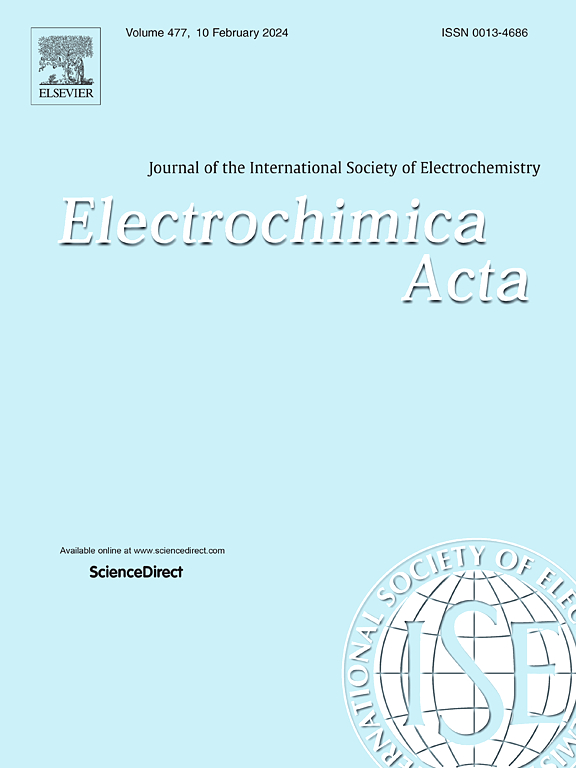纳米流体膜中的焦耳加热:软表面层电荷分布的影响及其对离子选择性、离子电流整流和电渗透流动的影响
IF 5.6
3区 材料科学
Q1 ELECTROCHEMISTRY
引用次数: 0
摘要
纳米流体系统有望应用于水净化、能量转换和分子传感,但焦耳加热往往限制了它们的性能。本文通过数值模拟研究了圆柱形纳米通道壁上聚电解质层(PEL)内电荷分布对其热耗散和关键电动力学特性的影响。三种构型:单极,双极和三极,在稳态条件下使用耦合泊松-能-普朗克,纳维-斯托克斯和能量方程进行了检查。结果表明,与单极和三极结构相比,双极纳米通道具有更好的热管理性能。具体来说,当电解液浓度比λc=100λc=100,外加侧电压Vapp=5VVapp=5V时,双极纳米通道中的焦耳加热为523 nW,比单极和三极情况下的675 nW减少了22.5%。考虑到焦耳热值超过500 nW在纳米流体系统中是实质性的,这种减少突出了双极纳米通道在减轻散热方面的有效性。此外,双极纳米通道提高了EOF速度,在λc=10λc=10时达到了9.83 × 10−3 m/s的最大值,显著超过了单极和三极设计的EOF速度,其最大EOF速度分别为2.39 × 10−3 m/s和2.85 × 10−3 m/s。这是由于双极结构的能力,更好地调节内部电场和提高离子迁移率。双极纳米通道进一步表现出优异的离子电流整流,使其适用于离子晶体管和纳米流体二极管。这些发现表明,双极电荷调制为减轻热效应和优化纳米流体器件性能提供了有效的策略。该研究有助于合理设计用于海水淡化、离子门控及相关技术的节能纳米流体膜。本文章由计算机程序翻译,如有差异,请以英文原文为准。


Joule heating in nanofluidic membranes: Influence of soft surface layer charge distribution and implications for ion selectivity, ionic current rectification and electroosmotic flow
Nanofluidic systems hold promise for applications in water purification, energy conversion, and molecular sensing, yet Joule heating often limits their performance. This study numerically investigates how the charge distribution within polyelectrolyte layers (PEL) on cylindrical nanochannel walls influences thermal dissipation and key electrokinetic properties. Three configurations: unipolar, bipolar, and tripolar, are examined using coupled Poisson–Nernst–Planck, Navier–Stokes, and energy equations under steady-state conditions. The results evidence that bipolar nanochannels exhibit superior thermal management compared to unipolar and tripolar configurations. Specifically, at an electrolyte concentration ratio across the channel and for an applied lateral voltage , Joule heating in bipolar nanochannels was 523 nW, a 22.5% reduction compared to the 675 nW obtained for both unipolar and tripolar cases. Given that Joule heating values exceeding 500 nW are substantial in nanofluidic systems, this reduction highlights the effectiveness of bipolar nanochannels in mitigating thermal dissipation. Furthermore, bipolar nanochannels enhanced EOF velocity, achieving a maximum value of 9.83 × 10−3 m/s at , which significantly exceeds the performance of unipolar and tripolar designs with maximum EOF velocities of 2.39 × 10−3 m/s and 2.85 × 10−3 m/s, respectively. This is attributed to the bipolar configuration’s ability to better regulate internal electric fields and enhance ion mobility. Bipolar nanochannels further exhibited superior ionic current rectification, making them suitable for applications in ionic transistors and nanofluidic diodes. These findings suggest that bipolar charge modulation offers an effective strategy for mitigating thermal effects and optimizing nanofluidic device performance. This study contributes to the rational design of energy-efficient nanofluidic membranes for desalination, ionic gating, and related technologies.
求助全文
通过发布文献求助,成功后即可免费获取论文全文。
去求助
来源期刊

Electrochimica Acta
工程技术-电化学
CiteScore
11.30
自引率
6.10%
发文量
1634
审稿时长
41 days
期刊介绍:
Electrochimica Acta is an international journal. It is intended for the publication of both original work and reviews in the field of electrochemistry. Electrochemistry should be interpreted to mean any of the research fields covered by the Divisions of the International Society of Electrochemistry listed below, as well as emerging scientific domains covered by ISE New Topics Committee.
 求助内容:
求助内容: 应助结果提醒方式:
应助结果提醒方式:


